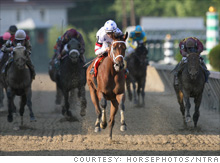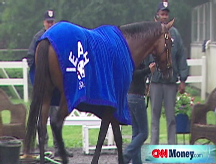 |
Commentary: | |
| SportsBiz | ||
Why Big Brown can't save horse racing
Even if he becomes the first Triple Crown winner in 30 years, the one-time 'Sport of Kings' is doomed.

 |
| Big Brown cruises to an easy win the Preakness, setting up his try for horse racing's Triple Crown at the Belmont. |
NEW YORK (CNNMoney.com) -- Horse racing fans are likely to flock to Belmont Park in record numbers Saturday to see Big Brown take a shot at history.
Forecasts are for both beautiful weather and the first Triple Crown winner in 30 years. Then there's the fact that the majority owners are from Long Island while a minority owner owns a trucking company in Brooklyn and named Big Brown after United Parcel Service (UPS, Fortune 500).
Did I mention that the trainer went from being broke and sleeping in a horse barn to the top of the sport of kings?
Add all that up and you've got the best story in sports this year.
Officials are hoping more than 100,000 will show up to watch the Belmont Stakes, the last leg of the Triple Crown. Attendance might even beat the record of 120,000 in 2004, when another blue collar favorite, Smarty Jones, from nearby Philadelphia, lost his chance for the Triple Crown by a nose. And the race, televised on ABC, also should generate big ratings.
But even if Big Brown, an overwhelming favorite, wins the Belmont Stakes, long-term success for the sport of horse racing remains a huge long shot.
Those who follow the industry say there's little that can turn around the sport. When Affirmed won the last Triple Crown, a horse race was still the only place most Americans could place a legal bet. Now, casinos abound, along with state lotteries and online gambling.
What once was among the top three spectator sports in the country, dwarfing football and basketball in popularity, is an afterthought for most sports fans.
"I don't see a Triple Crown revolutionizing the sport all of sudden," said Stephen Altebrando, an analyst who follows the publicly-traded horse track stocks for Sidoti & Company. "It's likely that wagering will be up, and ratings will be up. But it's been in a decline for decades, and that's not changing."
Big Brown will be trying for history at a track that is operating this year under bankruptcy protection.
The New York Racing Association, which operates Belmont and two other major tracks in the state, even threatened to halt racing this season as it sought to negotiate a new long-term contract with the state. The NYRA wants taxpayer subsidies and the right to put video poker machines at its tracks.
This comes even though Belmont has seen its three largest crowds in its history this decade as well as its six largest wagering pools. All three record attendance days were Belmont Stakes days when the favorite was trying for the Triple Crown, and four of the biggest betting pools took place on days when the Belmont Stakes was run.
But the fact is that on other days of the year, you'll find far more empty seats than excitement at Belmont. The same is true for most of the other top tracks in the country.
Finding a profitable race track in this country right now is tougher than trying to find someone that can name the winners of the past few Belmont Stakes.
Many regional tracks are now hanging by a thread and could be out of business in the next decade. Even if they survive, it's likely to be due to revenue from video poker or other forms of gambling, rather than on the racing itself.
If you think that Belmont, Pimlico or Churchill Downs (CHDN) would be better off from the reduced competition from the smaller tracks, you'd be wrong. They've come to depend upon wager revenue from simulcasts of their races at the smaller tracks.
"Those tracks are our partners in simulcasting," said John Lee, spokesman for the NYRA. "Whatever cuts into people losing their interest in horse racing is not a good thing for us."
Amid the feel good story of Big Brown, it's tough to forget that the sport has its dark side. The jockeys are the most exploited and at risk athletes in any U.S. sport, barely surviving on subsistence wages and pathetic benefits.
Most race horses are treated far better by owners than are their riders. But in-breeding of thoroughbreds in an attempt to create champions has created a population of beautiful but fragile competitors. In this year's Derby field, all 20 horses were the descendants of a single horse, Native Dancer, which finished second in the 1953 Derby.
And in this year's Kentucky Derby, filly Eight Belles stumbled after a surprisingly strong second-place finish, broke her leg and received a lethal injection on the track from veterinarians who could do nothing to save her.
The 2006 Derby winner Barbaro broke his leg in the Preakness, the second leg of the Triple Crown, and while he survived for eight months of intensive care, he eventually also had to be put down.
Even if Big Brown wins this Saturday, his racing career is likely to be over almost before it starts, as he moves onto the truly profitable part of his career -- fathering horses. His breeding rights have already been sold for $50 million. It's tough to think of any other sport where the pinnacle of success virtually guarantees a quick retirement.
So tune in Saturday if you a have a moment to witness Big Brown's run at history. Unfortunately, it's possible it's the last time you'll even bother to watch a horse race. ![]()



